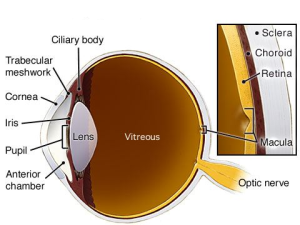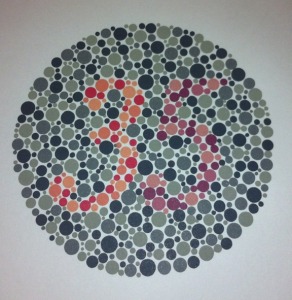Color Blind is a term that is often thrown around and usually with negative connotations. But for someone who is color blind, what does it actually mean and how did it happen? What does it mean if your child is diagnosed with color deficiency? What does the world look like to someone who is color blind?
All great questions we will answer today on Eye to the Future.
What is Color Blind?
 Before we get into what it means to be color blind or color deficient, let’s first look at how we actually see color. As discussed in a past blog post on how animals see in the dark, there are two types of light sensing cells in the retina: Rods and Cones. Rod cells in the retina are good at sensing movement and work well under dim illumination. Cones cells, by contrast, need lots of light to work properly, but are capable of discerning incredible detail as well as sensing color.
Before we get into what it means to be color blind or color deficient, let’s first look at how we actually see color. As discussed in a past blog post on how animals see in the dark, there are two types of light sensing cells in the retina: Rods and Cones. Rod cells in the retina are good at sensing movement and work well under dim illumination. Cones cells, by contrast, need lots of light to work properly, but are capable of discerning incredible detail as well as sensing color.
What was not discussed before, is that there are actually three different types of cones cells in the human eye that each sense different wavelengths of light: one type that senses the color Green, one for Red, and one for Blue. When light enters the eye, these three cells are activated to varying degrees based on the color or wavelength of the light.
Astonishingly, with just these three different color sensing cones types, the human eye is able to distinguish over 7 MILLION different colors!! Now that’s pretty cool.
But what happens if one, two, or even all three of these color cells are either not working properly or completely absent? The result is color deficiency or color blindness.
Types of Color Blindness
There are two forms of color deficiency: acquired and hereditary (i.e. genetic). Acquired color blindness occurs from some uncommon eye diseases or as a rare side effect of some medications, however, today we will discuss the far more common hereditary form.
Hereditary color deficiency is very common and has a strong male tendency, afflicting just over 1 in 12 males but only 1 in 200 females. Females are much more likely to “carry” the gene for color deficiency and pass it to their sons, whereas males are more likely to “express” the condition and actually be color blind themselves (more detailed explanation).
Many people believe that color blindness means a total lack of color vision. True color blindness can occur when just one of the three color sensing cells develops: this condition is called monochromacy. In actuality though, this condition is exceedingly rare (about 1 in 1 million new births).
Ironically enough, the vast majority of “color blind” individuals actually do see color. However, they see color differently because they only have two of the three cone types (suffix –anopia) or they have all three cones cell types but one of them is not functioning properly (suffix –anomaly). These conditions are named for what color cell type is defective and statistically it is most often the Green color cone cell type that is affected. As you can see below, if any cone cell type is missing or ineffective it has a dramatic effect on the way color is perceived.
Normal Vision
Protanopia or Protanomaly – Red Cone Cells absent or defective
Deuteranopia or Deuteranomaly – Green Cone Cells absent or defective
Tritanopia or Tritanomaly – Blue Cone Cells absent or defective

Diagnosis, Treatment, and Impact of Color Deficiency
 Diagnosis of color deficiency is very straightforward during a normal eye exam. This is done by using colored plates with dots in various patterns to spell out letters, numbers, lines, or shapes. These color plates (like the Ishihara plates at right) use specific colors chosen to be difficult for color deficient individuals to tell the difference. As a result, these individuals have trouble identifying the number or numbers on the plate, but for a color normal individual this will be very easy.
Diagnosis of color deficiency is very straightforward during a normal eye exam. This is done by using colored plates with dots in various patterns to spell out letters, numbers, lines, or shapes. These color plates (like the Ishihara plates at right) use specific colors chosen to be difficult for color deficient individuals to tell the difference. As a result, these individuals have trouble identifying the number or numbers on the plate, but for a color normal individual this will be very easy.
Considering that color vision defects are mostly a generic/inherited condition, there is really no effective treatment to regrow or fix cone cells that are either absent or not working properly from birth. The good news is that most of the time being color blind or color deficient has very little impact on an individual’s day to day lives. There are some professions that simply require normal color vision like an artist or painter, airplane pilot, policeman or fireman, as well as licensing for some commercial vehicles. However, for the most part, being color blind or color deficient, is quite common and does not prevent normal eye development, academic achievement, or professional success.
Aside from some occasional gentle ribbing by a spouse or coworker about a questionable attire selection, these individuals live normal and colorful lives.
As always, thank you for stopping by Eye to the Future and keep those questions coming!
Take care of those eyeballs!
– Dr. Wolf
For Loads more great information on Color Deficiency as well as some shocking examples of vision with color deficiency please visit the Colour Blind Awareness website.





